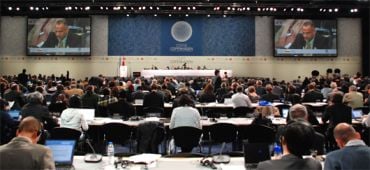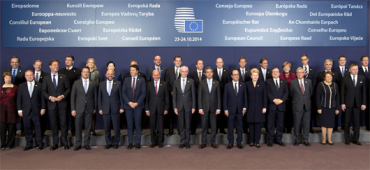
Maire de Copenhague
Cities play a decisive role in ensuring a more sustainable future. In Copenhagen, we work to become the first carbon-neutral capital – and along with other cities we will lead the way for national governments to a successful COP21 in Paris.
More than half of the world’s population lives in cities and cities are responsible for about 75 per cent of all CO2 emissions. This puts cities from all over the world – and their mayors – at the centre of the battle against climate change. Not only do we have the responsibility for dealing with the effects of climate change; we hold the key to preventing it from getting worse. Cities are in the frontline when it comes to resolving specific problems and putting strategy into action. We have the experience required to tackle problems related to climate changes locally and globally.
Copenhagen already feels the impact of a changing climate.
Let me give you an example: In 2011, Copenhagen experienced a cloud burst with more than 150 millimetres of rain in less than two hours. We had insurance damages amounted to almost 1 billion Euros. Thus, Copenhagen already feels the impact of a changing climate. On top of that we face the dual challenge of a rapidly growing population and limited space to build. How can we as a city cope with this challenge?
Copenhagen: Green solutions and cross-sector cooperation
First of all, intelligent urban planning is essential to prevent a massive increase in CO2 emissions – especially during a period when the city’s population is projected to grow 20 percent in the span of ten years. In Copenhagen, we are rising to the challenge and taking it a step further: By 2025 we will be the world’s first CO2-neutral capital. As a result of our green solutions we are already well on our way; CO2 emissions are down 40 per cent since 1995. The rest of the gains will be made by installing 100 new wind turbines, expanding our public transport system and converting our power stations from fossil fuels to biomass.
By 2025 we will be the world’s first CO2-neutral capital.
Secondly, in order to succeed it requires a great deal of involvement by residents and, not least, partnerships with businesses. Initiatives like these cannot be accomplished by a city council alone. By cooperating with businesses, we hope to make Copenhagen an international centre for clean tech development. There are currently about 500 clean tech companies, and more are coming every year. The OECD has identified Copenhagen as a global leader when it comes to creating growth and jobs in the green sector, and at the national level it outpaces all other sectors of the Danish economy. A big part of the reason for the success is the political willingness to invest in the sector. A carbon neutral Copenhagen will provide Danish clean tech companies with a local proving ground for testing and demonstrating their technologies.
Going green pays off
Being carbon neutral is just one part of being a sustainable city. Equally important are economic growth and, ultimately, a high level of quality of life. In times of economic challenges, we need to find new ways to create growth and jobs. And we have found that going green pays off – an important point, if cities all over the world are to choose the green path.
There are benefits to improve bicycle infrastructure, to building more sustainable building and cleaning the harbour. The returns can be measured in terms of more than just a healthier climate, improved health and increased quality of life. They can be also calculated in terms of hard cash; investments will bring returns.
Building up a bicycle infrastructure, for example, does more than just reduce CO2 emissions and air pollution. It also leads to more people taking their bikes to work, which in turn leads to improved individual health and lower medical costs. It is estimated that more than a half of the investments put into improving the energy efficiency of school buildings, cultural centres, homes and offices will be repaid through lower energy costs by 2025.
The extensive task of managing the climate changes can seem so massive that it paralyzes nations.
Our focus on creating a city that is not just green and liveable but also has a vibrant economy earned us the prestigious title of European Green Capital 2014. Sharing solutions among businesses, residents and other cities was the primary focus for our year as Green Capital before we handed over the title to Bristol.
Cities hold the key to a sustainable future
But how can cities take on more responsibility and actually do something about the global challenge that climate changes represent? We need to acknowledge the crucial role cities play in the effort to reduce CO2 emissions. The extensive task of managing the climate changes can seem so massive that it paralyzes nations as we witnessed at COP15 in Copenhagen in 2009, where national leaders failed to make a binding agreement. But city leaders from all over the world actually managed to meet at Copenhagen City Hall during COP15 and agree on strengthening the cities climate efforts. Why?
Cities actually have several advantages when it comes to fighting climate change: First of all, we cannot afford to be paralyzed – we answer directly to the citizens and have to deal with urgent problems that demand immediate action. At the same time, citizens generally have more faith in city governments – as opposed to governments on a national level – and are generally characterized by a more active involvement from citizens. For instance, the green solutions in Copenhagen depend directly on the Copenhageners´ willingness to take the bike, install green roofs or to buy a share in a windmill. This opens up innovation and creative thinking and gives the cities a unique possibility to develop new green initiatives and to more effectively incorporate them in the city development together with the citizens. In cities, there is a shorter way from talking about a solution to actually getting it done, and we often see the effects of a decision way faster than with decisions on a national level. In short: The cities hold the key to a sustainable future.
Cities: Lead the way!
We have this unique opportunity to play a key role in fighting the climate changes in practice. For this to happen we must begin to share our local solutions and inspire each other in ways to deal with this common challenge.
That is why Copenhagen is currently working with cities globally to find new sustainable solutions and share the ones we already have in place. For instance, we are deeply involved in the work of global city network C40 to implement sustainable initiatives that will help address climate change: We’re leading the C40 Green Growth Network, which seeks to develop new ways of creating sustainable urban solutions combined with economic growth, innovation and job creation. And now we represent the 19 Innovator Cities in the C40 Steering Committee, which is an important forum for sharing and creating new sustainable urban solutions.
Time isn’t on our side...
A network like C40 is important for cities to share green thinking and intelligent sustainable solutions to our common challenges regarding climate changes. But time isn’t on our side. City leaders have to act here and now on the challenges our citizens are facing. And we have the perfect opportunity to do this waiting just around the corner: COP21.
The objective of the 2015 conference in December is to achieve, for the first time in over 20 years of UN negotiations, a binding and universal agreement on climate, from all the nations of the world. This is the perfect occasion for the cities to lead the way in sharing solutions and urging a binding agreement with ambitious objectives for the future climate change initiatives. At the same time COP21 will be an unparalleled opportunity to bolster business innovation and stressing partnerships in the climate change arena with cross-sector participants from business, government, investors, UN, NGO and civil society to work together in finding even better green solutions to our common challenge.
The changing climate is a common global challenge, where cities can – and must – lead the way. We have to seize this opportunity when we meet in Paris in December. By sharing our best ideas and solutions, we can go from great solutions locally to brilliant advances globally.










